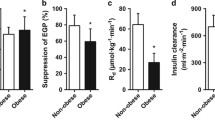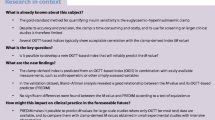Abstract
To verify whether the short intravenous insulin tolerance test (ITT) (a safe, reproducible, inexpensive, rapid and easy to perform measurement of insulin sensitivity) is a suitable test for insulin resistance screening in a general population, we measured in 60 non diabetic subjects, either non-obese (no.=40) or obese (BMI>28, no.=20) the K of glucose disappearance from plasma after ITT (KITT), plasma glucose (PG) and insulin (IRI) both fasting (FPG, FIRI) and at 120 min of OGTT (PG- 120, IRI- 120), and also triglycerides (Tg), cholesterol (Chol) and blood pressure (BP). Subjects were subdivided into quartiles according to KITT values. Average FPG, PG-120, FIRI, IRI-120, Tg and Chol values were progressively increased, and average HDL/Chol was progressively decreased from quartile 1 (the most insulin sensitive) to 4 (the most insulin resistant) (p<0.05, by 1-way ANOVA test). Also BP was increased in the insulin resistant patients, but statistical significance was not reached. Three or more of the studied parameters (FPG and/or PG-120, FIRI and/or IRI-120, Tg, HDL/Chol, mean BP) were altered (below the worst 25° percentile) in 64% of subjects from quartile 4; none of the subjects in quartile 1 was affected by such a cluster of alterations. KITT values ≤4.8 identified the cluster of insulin resistance related alterations with an accuracy of 82% (sensitivity=83.3%, specificity=80.5%). In healthy subjects with a wide range of BMI the ITT is a reliable procedure for screening for the cluster of metabolic alterations related to insulin resistance.
Similar content being viewed by others
References
Reaven G.M. Role of insulin resistance in human disease. Banting Lecture 1988. Diabetes 1988, 37: 1595–1607.
De Fronzo R.A., Ferrannini E. Insulin resistance: a multifaceted syndrome responsible for NIDDM, obesity, hypertension, dyslipidemia, and atherosclerotic cardiovascular disease. Diabetes Care 1991, 14: 173–194.
Reaven G.M. A syndrome of resistance to insulin-stimulated glucose uptake (Syndrome X): definition and implications. Cardiovasc. Risk Fact. 1993, 3: 2–11.
Hollenbeck G., Reaven G.M. Variations in insulin-stimulated glucose uptake in healthy individuals with normal glucose tolerance. J. Clin. Endocrinol. Metab. 1987, 64: 1169–1173.
Pyorälä K., Savolainen E., Kaukola S., Haapakoski J. Plasma insulin as coronary heart disease risk factor: relationship to other risk factors and predictive value during 9-year follow-up of the Helsinki policemen Study population. Acta Med. Scand. 1985 (Suppl.) 71: 38–52.
Fontbonne A.M., Eschiwege E.M. Insulin and cardiovascular disease: Paris Prospective Study. Diabetes Care 1991, 14: 461–469.
Zavaroni I., Bonora E., Pagliara M., Dall’Aglio E., Luchetti L., Buonanno G., Bonati P.A., Bergonzani M., Gundi L., Passeri M., Reaven G. Risk factors for coronary artery disease in healthy persons with hyperinsulinemia and normal glucose tolerance. N. Engl. J. Med. 1989, 320: 702–706.
Haffner S.M., Valdez R.A., Hazuda H.P., Mitchell B.D., Morales P.A., Stern M.P. Prospective analysis of the insulin resistance syndrome (Syndrome X). Diabetes 1992, 41: 715–722.
De Fronzo R.A., Tobin J.D., Andres R. The glucose clamp technique: a method of quantifying insulin secretion and resistance. Am. J. Physiol. 1979, 237: E214–E223.
Bonora E., Moghetti P., Zancanaro C., Cigolini M., Querena M., Cacciatori V., Corgnati A., Muggeo M. Estimates of in vivo insulin action in man: comparison of insulin tolerance tests with euglycaemic clamp and hyperinsulinaemic clamp studies. J. Clin. Endocrinol. Metab. 1989, 68: 374–378.
Hirst S., Phillips D.I.W., Vines S.K., Clark P.M., Hales C.N. Reproducibility of the short insulin tolerance test. Diabet. Med. 1993, 10: 839.
Young R.P., Critchley J.A.J.H., Anderson P.J., Lau M.S.W., Lee K.K.C., Chan J.C.N. The short insulin tolerance test: feasibility study using venous sampling. Diabet. Med. 1996, 13: 429–433.
Akinmokun A., Selby P.L., Ramaiya K., Alberti K.G.M.M. The short insulin tolerance test for determination of insulin sensitivity: a comparison with the euglycaemic clamp. Diabet. Med. 1992, 9: 432–437.
Matthews D.R., Hosker J.P., Rudenski A.S., Naylor B.A., Treacher D.F., Turner R.C. Homeostasis model assessment: insulin resistance and ?-cell function from fasting plasma glucose and insulin concentration in man. Diabetologia 1985, 28: 412–419.
Bonora E., Kiechl S., Willeit J., Oberhollenzer F., Egger G., Targher G., Alberiche M., Bonadonna R.C., Muggeo M. Prevalence of insulin resistance in metabolic disorders. The Bruneck Study. Diabetes 1998, 47: 1643–1649.
Author information
Authors and Affiliations
Corresponding author
Rights and permissions
About this article
Cite this article
Graci, S., Baratta, R., Degano, C. et al. The intravenous insulin tolerance test is an accurate method for screening a general population for insulin resistance and related abnormalities. J Endocrinol Invest 22, 472–475 (1999). https://doi.org/10.1007/BF03343592
Accepted:
Published:
Issue Date:
DOI: https://doi.org/10.1007/BF03343592




